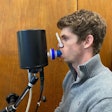
There is growing concern among the scientific community about the presence of microplastics in our environment. New research published in Scientific Reports suggests that the presence of these pollutants could lead to increased risk of cancer for people with respiratory illnesses like COPD and asthma.
The researchers wrote that microplastics have been detected in diverse ecosystems including marine and groundwater, agroecosystems, food and drinking water. They are released into the air from synthetic textiles, rubber tires or agricultural sheets and can be inhaled as wind-driven particles from city dust and salt aerosols, accumulating in the lungs.
These particles are challenging to remove and can remain in the lungs for extended periods of time. Though some are cleared away by mucous, ciliary activity and macrophages, the smaller particles cannot be effectively cleared by macrophages.
The study, which looked at a total of 29 patients — 11 healthy controls, 10 asthma patients and eight COPD patients — demonstrated that asthmatic and COPD airway epithelial cells exhibit a different reaction to microplastic fiber stimulation compared to healthy epithelial cells. The most significant response was associated inflammation of t helper 2 (Th2) cells, modulation of stress response and carcinogenesis — the early formation of cancer cells.
“Our findings indicate that asthmatic and COPD epithelial cells are more vulnerable to cancer-related immune responses following microplastic inhalation and improper airway clearance,” the researchers wrote. “The structural impairment of the airway epithelium in obstructive diseases enhances the impact of microplastic particles compared to healthy epithelium.”






















